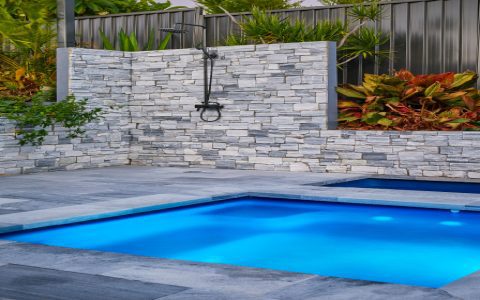A swimming pool bridge is a structural element built to span a portion of a swimming pool, serving either functional or aesthetic purposes, or a combination of both. These bridges can enhance the visual appeal of a pool area, provide access across the water, or connect different deck sections.
Types of Swimming Pool Bridges
Pool bridges vary significantly in design and purpose:
- Functional Access Bridges: Primarily designed to provide a walkway over the pool, connecting two points, such as different sides of a deck or an island feature within the pool.
- Aesthetic Bridges: Often serve as decorative focal points, enhancing the landscape and pool design. While some may be walkable, their primary role is visual enhancement.
- Fixed Bridges: These are permanent, sturdily built structures, typically constructed from materials like wood, stone, concrete, or metal.
- Beam Bridges: A common and straightforward design, utilizing horizontal beams supported by abutments at each end.
- Arch Bridges: Feature an arched structure, offering an elegant and classic look, often requiring more complex engineering.
Key Design Considerations
Successful swimming pool bridge design incorporates several critical factors:

- Safety: This is paramount. Surfaces must be non-slip, especially when wet. Railings or barriers are often necessary, depending on the bridge's height and length, and must comply with local safety codes.
- Load Capacity: The bridge must be engineered to safely support the anticipated weight of pedestrians and any potential maintenance equipment.
- Clearance: Adequate vertical clearance above the water level is essential for swimmers to pass underneath safely and for pool cleaning equipment. Horizontal clearance from pool edges may also be a factor.
- Material Selection: Materials must be durable, water-resistant, and able to withstand pool chemicals and varying weather conditions.
- Aesthetics and Integration: The bridge's style, scale, and materials should complement the existing pool design, decking, and overall landscape architecture.
- Drainage: Proper surface drainage must be incorporated to prevent water pooling, which can lead to slippery conditions and material degradation.
- Maintenance Requirements: Consideration should be given to the ease of cleaning and long-term upkeep of the chosen materials and design.
Common Materials
The choice of material significantly impacts the bridge's appearance, durability, cost, and maintenance:
- Treated Wood: Hardwoods like teak or ipe offer natural beauty and good water resistance but require regular sealing or oiling. Pressure-treated pine is a more budget-friendly option but may have a shorter lifespan.
- Stone and Concrete: Natural stone (e.g., flagstone, granite) or pre-cast concrete elements provide excellent durability and a robust appearance. Poured concrete can be customized but is heavy and requires substantial support.
- Metals: Stainless steel, powder-coated aluminum, or wrought iron are used for structural components or entire bridges. Corrosion resistance is a key factor.
- Composites: Wood-plastic composites (WPC) offer a low-maintenance alternative to wood, often with good slip resistance and a variety of finishes.
- Glass: Toughened and laminated safety glass can be used for railings or even bridge decking for a contemporary, transparent look, though it requires specialized engineering and diligent cleaning.
Benefits of Swimming Pool Bridges
- Enhanced Aesthetics: A well-designed bridge can serve as a striking focal point, adding elegance and character to the pool area.
- Improved Accessibility and Circulation: Provides convenient pathways across the pool, improving flow around the pool deck or access to features like spa areas or islands.
- Zone Definition: Can help visually or physically separate different areas of a larger pool or pool deck, creating distinct functional zones.
- Increased Perceived Value: A unique and high-quality pool bridge can enhance the overall appeal and potential resale value of a property.
Potential Challenges and Considerations
- Cost: Custom design, quality materials, and professional installation can represent a significant investment.
- Maintenance: All bridges require some level of maintenance. Materials exposed to pool water and sunlight will degrade over time if not properly cared for. Cleaning underneath the bridge can also be challenging.
- Safety Regulations: Compliance with local building codes, safety standards (e.g., railing height, gap spacing), and potentially specific pool safety regulations is crucial.
- Space Constraints: A bridge will take up space both over the water and potentially on the deck for its abutments, which may not be suitable for all pool sizes or layouts.
- Impact on Pool Use: The bridge's location and clearance must not unduly obstruct swimming lanes or recreational use of the pool.







